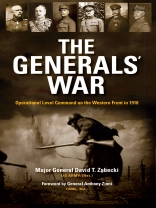Known as the War to End all Wars and the Great War, World War I introduced new forms of mass destruction and modern technological warfare. When the Bolsheviks pulled Russia out of the war in late 1917, the Germans turned their offensive efforts to the Western Front in an attempt to win the war in 1918. But as fresh American troops entered Europe, the strategic scales tipped against Germany.
Much of how World War I played out turned on the plans and decisions of the senior-most German and Allied commanders. The Generals’ War explores the military strategies of those generals during the last year of the Great War. These six very different men included Germany’s Field Marshal Paul von Hindenburg and General Erich Ludendorff; France’s Marshals Ferdinand Foch and Philippe Pétain; Great Britain’s Field Marshal Sir Douglas Haig; and the United States’ General John Pershing. Although history remembers none of them as great captains, these six officers determined for better or worse how World War I was fought on the battlefields of the Western Front between November 1917 and November 1918.
The Generals’ War is a landmark exploration of the generalship that shaped the very framework of modern warfare as we know it today and provides a comprehensive and detailed analysis on the senior commanders of the Great War.
Jadual kandungan
Foreword by General Anthony Zinni, USMC (Ret)
Table and Maps
Glossary
I. Generalship in the Great War
II. Battlefield Realities
III. The Strategic Situation
IV. The Commanders-in-Chief
V. The Yanks are Coming
VI. Two Conferences in November 1917
VII. The Gathering Storm
VIII. MICHAEL and GEORGETTE
IX. GNEISENAU and BLÜCHER
X. MARNESCHUTZ-REIMS and the Second Battle of the Marne
XI. Le Hamel to Mount St. Quentin
XII. Closing to the Hindenburg Line
XIII. The Allied General Offensive
XIV. The Armistice
XV. The Fluctuating Verdict of History
Appendix I: Biographical Chronologies
Appendix II: Note on General Officer Ranks
Mengenai Pengarang
David T. Zabecki (Lt. Gen. Ret) is author or editor of nine military history books, including The German 1918 Offensives: A Case Study in the Operational Level of War, and the assistant editor of several military history encyclopedias. He is editor of Vietnam Magazine, the Senior Historian of the Weider History Group, the world’s largest publisher of history magazines, and author of numerous articles, book reviews, and encyclopedia entries, all dealing with military topics.












